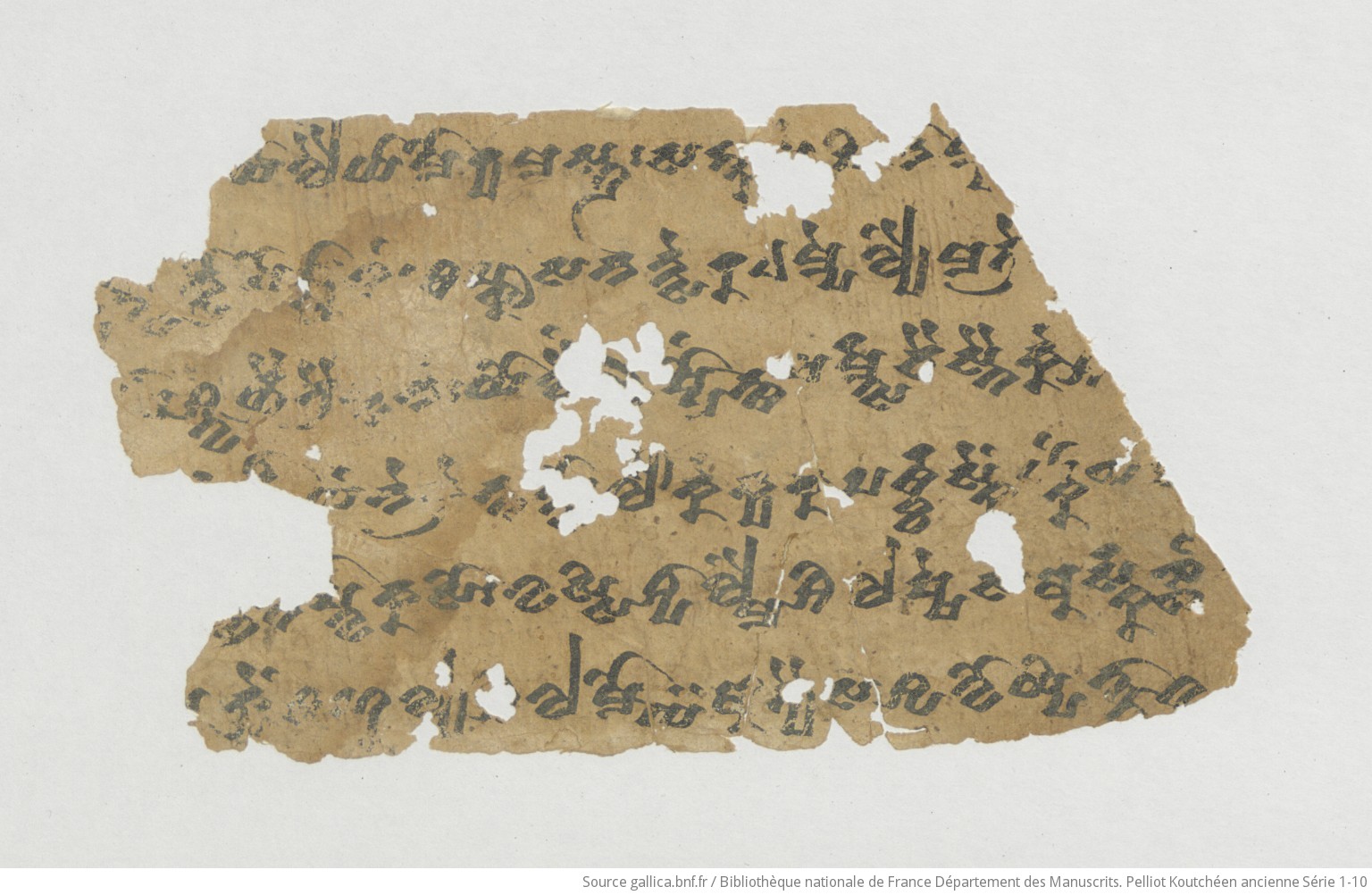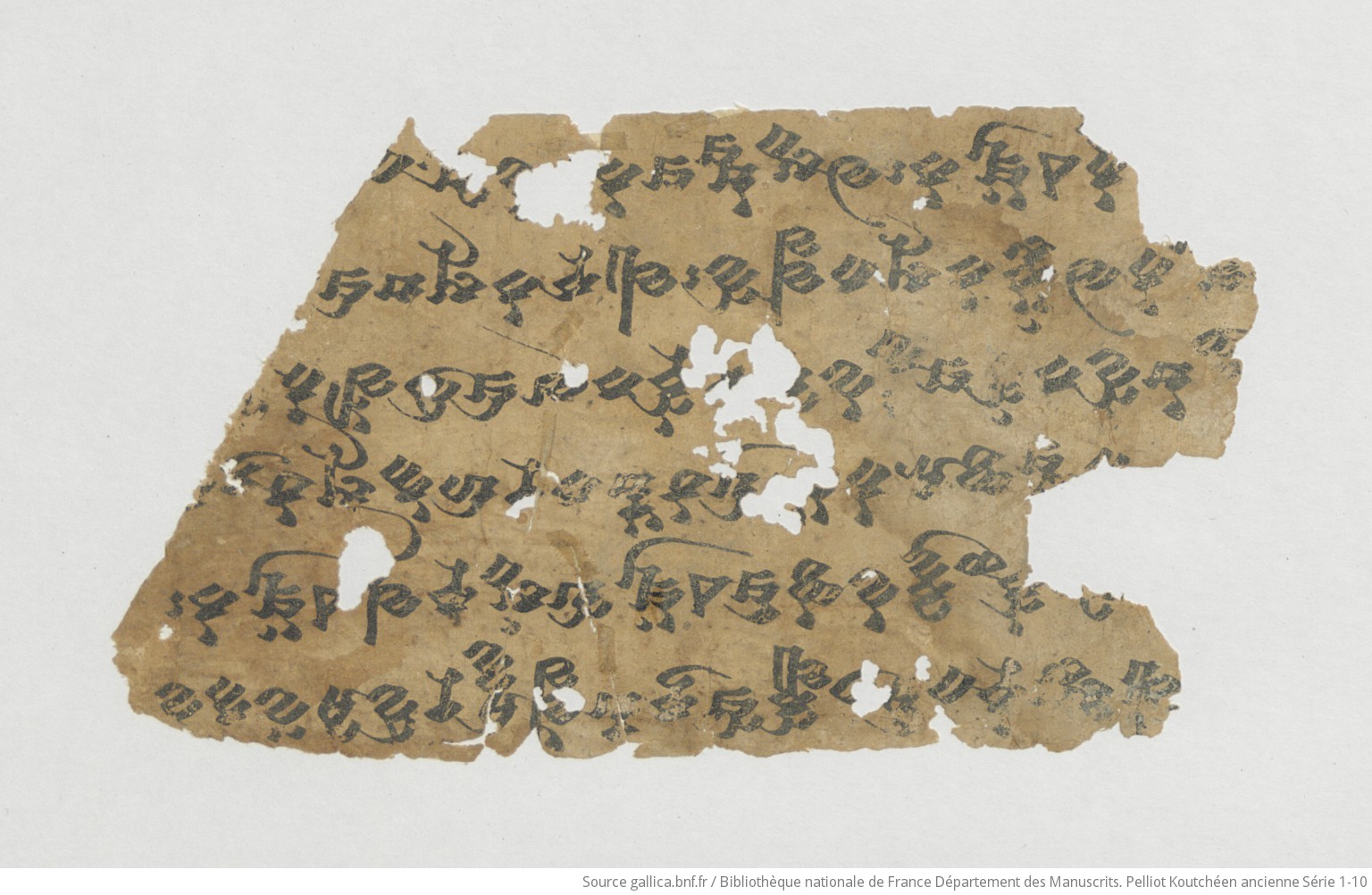Work in progress
PK AS 7A
| Known as: | PK AS 7A; Pelliot Koutchéen Ancienne Série 7A; K 1 |
|---|
| Cite this page as: | Georges-Jean Pinault; Melanie Malzahn (collaborator); Michaël Peyrot (collaborator). "PK AS 7A". In A Comprehensive Edition of Tocharian Manuscripts (CEToM). Created and maintained by Melanie Malzahn, Martin Braun, Hannes A. Fellner, and Bernhard Koller. https://cetom.univie.ac.at/?m-pkas7a (accessed 14 Jul. 2025). |
|---|
Edition |
| Editor: | Georges-Jean Pinault; Melanie Malzahn (collaborator); Michaël Peyrot (collaborator) |
|---|
| Date of online publication: | 2012-02 |
|---|
Provenience |
| Main find spot: | Duldur-akur |
|---|
| Expedition code: | 882 |
|---|
| Collection: | Bibliothèque nationale de France, fonds Pelliot Koutchéen (Paris) |
|---|
Language and Script |
| Language: | TB |
|---|
| Linguistic stage: | classical |
|---|
| Script: | classical |
|---|
Text contents |
| Title of the work: | Karmavibhaṅga |
|---|
| Text genre: | Literary |
|---|
| Text subgenre: | Doctrine |
|---|
| Verse/Prose: | verse |
|---|
| Meter: | 4335 (4x) |
|---|
Object |
| Manuscript: | Karmavibhaṅga α |
|---|
| Material: |
ink
on paper |
|---|
| Form: | Poṭhī |
|---|
| Size (h × w): | 9.2 × 15.3 cm |
|---|
| Number of lines: | 6 |
|---|
| Interline spacing: | 1.5 cm |
|---|
Images
Transliteration
| a1 | /// y[o] lai yā mo rya ma stra : sa ṅka [ṣ](·)e pi t[o] m[y]· /// |
|---|
| a2 | /// – pw[i] ks[o] po «p»lā taṃ 20 4 sa na ntse ra e mpe lyeṃ ma tre /// |
|---|
| a3 | /// [p]ī śwa rñai nrai nta ne : yo laiṃ (–) ṣmoṃ¯ ¯ts ṣa rmtsa cai snai ke¯ ¯ś /// |
|---|
| a4 | /// ·[e] r· ·ī yaṃ ne kre nta n[ts]o lo ke kya ka pa rska skeṃ ykāṃ s̝a [l]·· /// |
|---|
| a5 | /// [ñ]· [n]t· pw[ī] ka so : wa ssi śpā lmeṃ śi la ṣṣe sa a rska s̝s̝aṃ /// |
|---|
| a6 | /// [ra] kseṃ 20 8 lya śi la mo¯ ¯yä a tyai sa śu wo ypi nt[w]ā¯ ¯t – – – /// |
|---|
| b1 | /// lpā ssi ke¯ ¯t śī¯ ¯l klyo mo ku rp· lle śtwā ra wī śi wä nta(·) w(·) /// |
|---|
| b2 | /// ·i nau¯ ¯s̝ kwri we ñce rmā e mpreṃ po staṃ ka l(·) ra e mpreṃ ne : /// |
|---|
| b3 | /// ·t· [ṣ]m(·) ñca śā te (·)ai pr[o] ce rṣai na ra hā nte sū ce¯ ¯u [sa] /// |
|---|
| b4 | /// [ñ]ñ· ṣe wau na toṃ ma¯ ¯nt we [ṣ](·)i (–) kau na 30 mā ñi lau te ·[au] /// |
|---|
| b5 | /// m· [s]a te o ksaiṃ ne sū ta llā wo : lya kā ne sū ṣa mā /// |
|---|
| b6 | /// t[w]e e mpreṃ ne : o¯ ¯st ṣme ma ne (–) [w]e ṣṣi¯ ¯t /// |
|---|
Transcription
Translation
| a1 | ... He does bad deed[s]. He trades the price of the Saṃgha. ... |
|---|
| a2 | ... Avoid [pl.] all [idle or evil] talks! Like the horrible, sharp-xy (weapons? army?) of the enemy ... |
|---|
| a3 | ... to the hells beginning with the Avīci [hell]. Because of bad friends these ones ... innumerable ... |
|---|
| a4 | ... in the retinues of the good ones. The snakes/insects (?) frighten (because of) aversion ... |
|---|
| a5 | ... Avoid [pl.] the possessions! Because of the excellent garment of good conduct one renounces ... |
|---|
| a6 | ... they spread ... . 28. One should lie [and] sit on the grass, one should eat alms ... |
|---|
| a6+ | ... in order to observe the good conduct. |
|---|
| b1 | By whom the noble good conduct [has to be] taken as concern, he should avoid the four things [= errors]. |
|---|
| b2 | If you do not tell the truth before, afterwards you will suffer in the truth. |
|---|
| b2+ | There was a rich householder; |
|---|
| b3 | he was the brother of Narahānt. This one (did something) to that one ... |
|---|
| b4 | ... pretexts. He kept telling this sort of words. 30. “For me [there is] no opportunity ...” |
|---|
| b5 | This miserable has been reborn among oxen. This monk saw him ... |
|---|
| b6 | ... you (sg.) ... in the truth ... you (sg.) kept saying (that) while remaining in the house ... |
|---|
Other
| b2 | If you [pl.] say the untrue before, you stay in truth afterwards. (Georges-Jean Pinault, p.c.) (Peyrot 2013b: 699) |
|---|
Commentary
Linguistic commentary
| * | There are several forms with o-mobile immediately in front of a colon/pāda end, i.e., in the normal position in verse. |
|---|
| * | There are two variants of the 2.pl. active transitive Imperative of wik(ā)-, pwikso (a2) and pwīkaso (a5), no doubt due to metrical requirements. |
|---|
| n3 | If -sa is the perlative affix (which is the only sensible semantic solution), it is wrongly placed after the adjective (instead of the substantive wassi). In addition, this clause has one syllable to many. One may surmise that the original, metrically correct text had the verse form śilṣesa. The copyist transposed it into the usual prose form. |
|---|
| n5 | The 2. plural middle kalträ is the first attestation of the expected zero-grade stem of the Sub I stem of käl- ‘to suffer, endure’ (1.sg. kelu). |
|---|
| n6 | Due to context narahānte is a genitive singular of a proper name Narahānt, which is obviously borrowed from Sanskrit, possibly a false rendering of narānta-. |
|---|
Philological commentary
| * | The meter seems to be 4 x 14 (7/7), but in a5 we have an eight-syllable colon. In a2 and a4 two cross signs slightly above the line can be seen; usually, this sign marks a correction, but here nothing was added or deleted. The crosses may, however, signal the omission of a whole pāda or stanza, since the written stanza numbers are difficult to reconcile with the lacunas, i.e. it seems that text is indeed missing. |
|---|
| n1 | The text contains the otherwise unknown ṣlātäṃ, but since there is a corrections cross after this form (though without visible correction), it is quite reasonable to assume a correction to plātäṃ ‘talks, speeches’. The form matre must be the first member of a compound, as in matre-wse ‘having a sharp poison’. |
|---|
| n2 | The reading °īyaṃne by Lévi is certain; hence the assumption by Sieg 1938: 4 to read °īyeṃne and to simply restore (kerc)īyeṃne is wrong. Actually, the restoration (w)[er](ts)īyaṃne makes much more sense with respect to the context. The segmentation of the akṣarsas before the verb parskäskeṃ is uncertain. We may deal with the adverb yaka; lokek could in theory be a form of lauke plus emphatic -k. However, the connection of these two adverbs with ‘frighten’ is not clear semantically. Therefore, one may venture the guess that lokekyaka is based on an incorrect sanskritization of a Middle Indic form of Sanskrit lohitaka- ‘some sort of insect’ (Edgerton 1953: 465b) or of Skt. lohitākṣa- ‘with red eyes’ (the name of a snake) (M-W, 909b). Accordingly, lokekyaka would be the plural of a noun lokekyak*. As for ykeṃ, the only sensible interpretation is to regard it as a form of an adverb yṅkeṃ ‘on the earth’ comparable to iṅkauṃ ‘by day’; note that the nasal in these formations may be missing (cf. yñakteṃ, yśāmna). It is unclear what the cross means, since there is no written correction. |
|---|
| n4 | The reading of the number 28 as per Lévi is certain (pace Sieg 1938: 4). One has to admit, however, that the restitution of the meter from the number of syllables (taking the pāda digits for granted) is difficult. |
|---|
Remarks
| * | The actual piece consists of two joint fragments, only the left part of which has been edited by Lévi and commented upon by Sieg. Only due to this joint giving clear stanza numbers it has been possible to distinguish between recto and verso side. Hence, the actual sides are in the reverse order in contrast to the first edition. |
|---|
References
other
Lévi 1933: 84; Sieg 1938: 2-4
Translations
Meunier 2013: a1 (180); Peyrot 2013b: b2 (699)
Bibliography
Edgerton 1953
Edgerton, Franklin. 1953. Buddhist Hybrid Sanskrit grammar and dictionary. New Haven: Yale University Press.
Lévi 1933
Lévi, Sylvain. 1933. Fragments de textes koutchéens. Udānavarga, Udānastotra, Udānālaṁkāra et Karmavibhaṅga, publiés et traduits avec un vocabulaire et une introduction sur le «tokharien». Paris: Imprimerie Nationale.
Meunier 2013
Meunier, Fanny. 2013. “Typologie des locutions en yām- du tokharien.” Tocharian and Indo-European Studies 14: 123–85.
Peyrot 2013b
Peyrot, Michaël. 2013b. The Tocharian subjunctive. A study in syntax and verbal stem formation. Vol. 8. Brill’s Studies in Indo-European Languages & Linguistics. Leiden/Boston: Brill.
Sieg 1938
Sieg, Emil. 1938. “Die Kutschischen Karmavibhaṅga-Texte der Bibliothèque Nationale in Paris.” Zeitschrift für Vergleichende Sprachforschung 65: 1–54.




